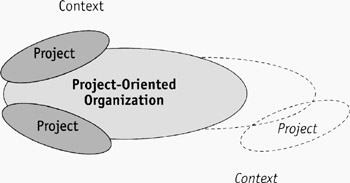The Model of the Project-Oriented Organization
|
A POO can be defined as an organization that:
-
Defines "Management by Projects" as an organizational strategy.
-
Applies temporary organizations for the performance of complex processes.
-
Manages a project portfolio of different project types.
-
Has specific permanent organization structures to provide integrative functions.
-
Applies a "new management paradigm."
-
Has an explicit project management culture.
-
Perceives itself as being project-oriented.
The POO considers projects not only as tools to perform complex processes, but also as a strategic option for the organizational design of the company, the division, or the profit center. By applying management by projects the following organizational objectives are pursued:
-
Organizational differentiation and decentralization of management responsibility
-
Quality assurance by project work and holistic project definitions
-
Goal orientation
-
Organizational learning.
For processes of different complexities, different organizations are adequate. The POO perceives projects and programs as temporary organizations for the performance of complex processes. For unique processes of medium to high complexity and short to medium duration (three months to twelve months), projects are the appropriate organization form. Projects can be defined for contracts for external clients as well as for product developments, marketing campaigns, or reengineering activities for internal clients.
A program (of projects) is a temporary organization for the performance of a process of high complexity. The projects of a program are closely coupled by overall program objectives, overall strategies, and common processes and methods. A program has a time limit and is medium or long term (six months to thirty-six months) in duration.
Typical programs are the development of a "product family" (and not of a single product), the implementation of a comprehensive information technology (IT) solution (such as SAP software), the reorganization of a group of companies in a holding structure, and large investments, such as an oil platform.
The more different project types a POO holds in its project portfolio, the more differentiated it becomes and the higher its management complexity becomes. In order to support the successful performance of the single projects as well as to ensure the compliance of the project objectives with the overall strategies, specific integrative structures, such as expert pools, a project management office, and project portfolio groups, are required. Some of these permanent organizations might be virtual (Figure 1).

Figure 1: Organization Chart of a POO
The POO is characterized by the existence of an explicit project management culture, i.e., by a set of project management-related values and norms. In the POO project management is considered as a business process, for which there exist specific procedures along with a common understanding of the project roles involved and the project management methods applied.
Further, in the POO the application of a new management paradigm is required. Traditional management approaches are emphasizing detailed planning methods, focusing on the assignment of clear defined work packages to individuals, relying on contractual agreements with clients and suppliers, and using the hierarchy as a central integration instrument. Compared with this traditional management approach the central features of the new management paradigm are:
-
Consideration of the organization as competitive advantage
-
Empowerment of employees
-
Process orientation
-
Teamwork in flat organizations
-
Continuous and discontinuous organizational change
-
Customer orientation
-
Networking with clients and suppliers.
The POO has dynamic boundaries and contexts (Figure 2). On the one hand the number and the sizes of the projects and programs are constantly changing, permanent and temporary resources are employed, and cooperation is organized in virtual teams. On the other hand varying strategic alliances are established and relationships to the different social environments of the different projects and programs are managed.

Figure 2: Dynamic Boundaries of the POO
In order to manage the dynamics of the POO, besides activities that reflect the corporate identity such as strategic controlling, clusters of projects such as chains of projects, a project portfolio, and networks of projects can be applied as new integrative structures.
Considering the timing in which sequential projects are performed, a chain of projects results. By relating a set of projects to each other according to a specific criterion, such as the technology applied or a geographic region, a network of projects results, and by considering all projects performed by an organization, the project portfolio results. A project portfolio is defined as a set of all projects the POO holds at a given point in time and the relationships between these projects. In comparison to a program a project portfolio is not an organization.
|
EAN: 2147483647
Pages: 207